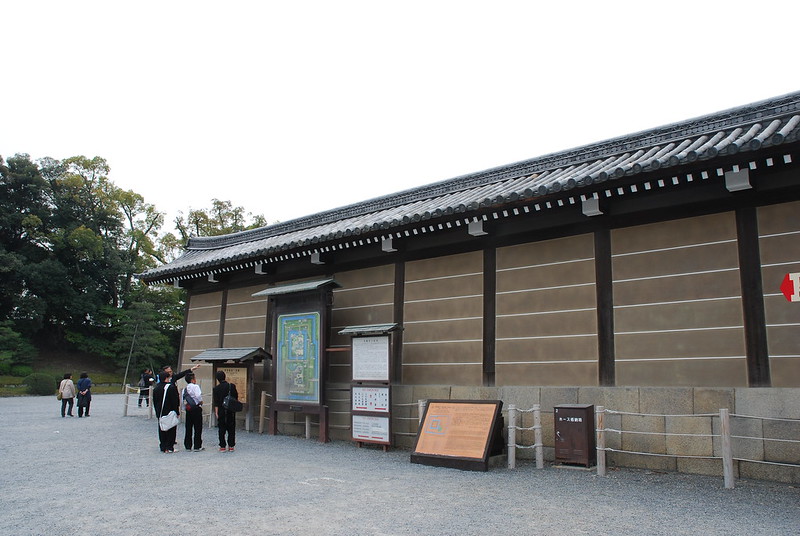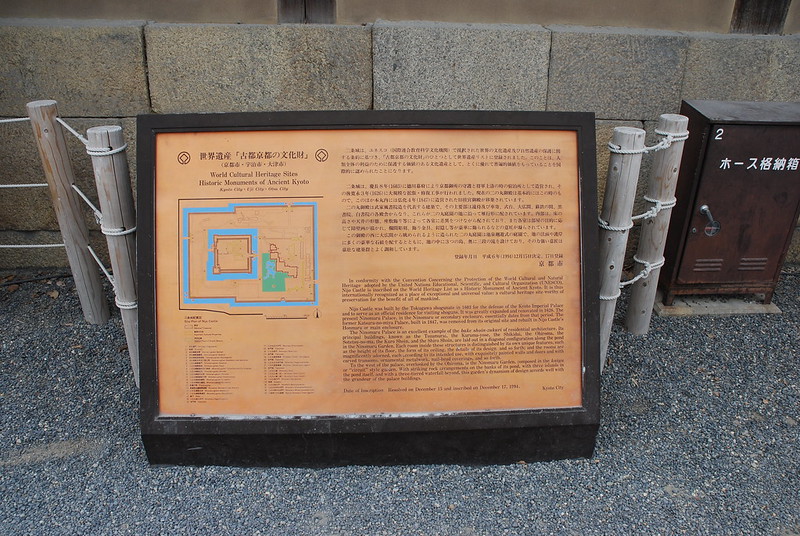東大手門から入って正面、二の丸御殿の築地塀のところに世界遺産の登録を示す案内板があります。


世界遺産「古都京都の文化財」(京都市・宇治市・大津市)
二条城は、ユネスコ(国際連合教育科学文化機関)で採択された世界の文化遺産及び自然遺産の保護に関する条約に基づき、「古都京都の文化財」のひとつとして世界遺産リストに登録されました。このことは、人類全体の利益のために保護する価値のある文化遺産として、とくに優れて普遍的価値をもっていることを国際的に認められたことになります。
二条城は、慶長8年(1603)に徳川幕府により京都御所の守護と将軍上洛の時の宿泊所として造営され、その後寛永3年(1626)に大規模な拡張・修復工事が行なわれました。現在の二の丸御殿は基本的にはこの時のもので、このほか本丸内には弘化4年(1847)に造営された旧桂宮御殿が移築されています。 二の丸御殿は武家風書院造を代表する建築で、その主要部は遠侍及び車寄、式台、大広間、蘇鉄の間、黒書院、白書院の各殿舎からなり、これらが二の丸庭園の池に沿って雁行形に配されています。内部は、床の高さや天井の形態、座敷飾り等によって各室に差異をつけながら配されており、また各室は部屋の目的に応じて障壁画が描かれ、欄間彫刻、飾り金具、釘隠し等が豪華に飾られるなどの意匠が凝らされています。 この御殿の西に大広間から眺められるように造られた二の丸庭園は池泉廻遊式の庭園で、池の法面や護岸に多くの豪華な石組を配するとともに、池の中に3つの島、奥に三段の滝を設けており、その力強い意匠は豪壮な建築群とよく調和しています。登録年月日 平成6年(1994)12月15日決定、17日登録
京都市World Cultural Heritage Sites
In conformity with the Convention Concerning the Protection of the World Cultural and NaturalHeritage adopted by the United Nations Educational, Scientific, and Cultural Organization (UNESCO), Niio Castle is inscribed on the World Heritage List as a Historic Monument of Ancient Kyoto. It is thus internationally recognized as a place of exceptional and universal value: a cultural heritage site worthy of preservation for the benefit of all of mankind.
Historic Monuments of Ancient Kyoto
Kyoto City・Uji City・Otsu City
Nijo Castle was built by the Tokugawa shogunate in 1603 for the defense of the Kyoto Imperial Palace and to serve as an official residence for visiting shoguns. It was greatly expanded and renovated in 1626. The present Ninomaru Palace, in the Ninomaru or secondary enclosure, essentially dates from that period. The former Katsura-no-miya Palace, built in 1847, was removed from its original site and rebuilt in Nijo Castle's Honmaru or main enclosure.
The Ninomaru Palace is an excellent example of the buke shoin-zukuri of residential architecture. Its principal buildings, known as the Tozamurai, the Kuruma-yose, the Shikidai, the Ohiroma, the Sotetsu-no-ma, the Kuro Shoin, and the Shiro Shoin, are laid out in a diagonal configuration along the pond in the Ninomaru Garden. Each room inside these structures is distinguished by its own unique features, such as the height of its floor, the form of its ceiling, the details of its design and so forth; and the rooms are magnificently adorned, each. according to its intended use, with exquisitely painted walls and doors and with carved transoms, ornamental metalwork, nail-head coverings, and so forth.
To the west of the palace, overlooked by the Ohiroma, is the Ninomaru Garden, composed in the kaiyu or "circuit" style garden. With striking rock arrangements on the banks of its pond, with three islands in the pond itself, and with a three-tiered waterfall beyond, this garden's dynamism of design accords well with the grandeur of the palace buildings.
Date of Inscription Resolved on December 15 and inscribed on December 17, 1994.Kyoto City

